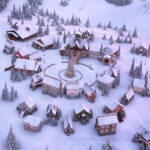Eleven days before his tragic assassination, President John F. Kennedy visited Arlington National Cemetery for the 1963 Veterans Day services. Little did anyone know that this hallowed ground would soon become his final resting place. On November 22, 1963, while on a campaign trip to Dallas, the world mourned as President Kennedy was fatally shot. This pivotal moment in American history led to countless questions, including, “Where Is Jfk Buried?” The answer lies in Arlington National Cemetery, a place of honor and remembrance for American heroes.
The Decision for Arlington: A Nation’s Grief and a First Lady’s Choice
John F. Kennedy is one of only two U.S. presidents interred at Arlington National Cemetery, the other being William Howard Taft. Upon Kennedy’s death, many naturally assumed he would be buried in Brookline, Massachusetts, his birthplace and childhood home. However, First Lady Jacqueline Kennedy held a different vision. Understanding the profound impact her husband had on the nation, she desired a gravesite that would be easily accessible to all Americans, a place where the public could pay their respects.
In making this significant decision, Jacqueline Kennedy consulted with President Kennedy’s brother, Robert F. Kennedy, and Secretary of Defense Robert S. McNamara, both of whom would also later be laid to rest at Arlington. The initial location chosen was a serene spot on a sloping hillside, thoughtfully positioned along an axis line connecting Arlington House and the Lincoln Memorial, symbolizing a link between different eras of American leadership and ideals.
The State Funeral and the Nation’s Pilgrimage
On November 25, 1963, the world watched as President Kennedy’s state funeral unfolded. Dignitaries from across the globe, including President Charles de Gaulle of France, Chancellor Ludwig Erhard of West Germany, Emperor Haile Selassie of Ethiopia, and Prince Philip of the United Kingdom, joined American mourners in paying tribute. A poignant flyover of fifty Navy and Air Force jets, followed by Air Force One dipping its wing in a final salute, marked the solemnity of the occasion. Millions followed the live television coverage, united in grief and admiration.
Alt text: Bird’s-eye view of John F. Kennedy’s grave at Arlington National Cemetery, showing the eternal flame and surrounding landscape.
The outpouring of national grief was immense, leading to an unprecedented surge in requests for burials at Arlington National Cemetery. It became clear that JFK’s final resting place would become a site of national pilgrimage.
From Simple Plot to Hallowed Ground: The Evolution of the Gravesite
Initially, President Kennedy’s grave was a modest 20-foot by 30-foot plot, marked by a simple white picket fence. In the year following his death, an astonishing number of people visited to pay their respects, sometimes reaching 3,000 per hour and an estimated 50,000 on weekends. Within three years, over 16 million people had visited, highlighting the need for a more permanent and accommodating memorial.
Recognizing the overwhelming public response, cemetery officials and the Kennedy family collaborated to create a more suitable and enduring gravesite. Construction began in 1965 and concluded on July 20, 1967. The centerpiece of this redesigned space is an eternal flame, ignited by Mrs. Kennedy herself, emanating from the center of a five-foot circular granite stone at the head of the grave.
Alt text: Close-up of the Eternal Flame burning brightly at John F. Kennedy’s gravesite in Arlington National Cemetery, symbolizing everlasting remembrance.
The Kennedy family contributed to the costs directly related to the grave area, while the federal government allocated $1,770,000 as part of the 1965 Public Works appropriation to enhance the surrounding area and ensure it could accommodate the vast number of visitors respectfully.
A Family’s Legacy at Arlington
President Kennedy’s grave is not just his individual resting place; it has become a Kennedy family plot within Arlington National Cemetery. Nearby, lie two of his brothers: Robert F. Kennedy, assassinated in 1968 and interred in 1971, and Senator Edward M. Kennedy, buried in an adjacent plot after his passing in 2009. A memorial marker also stands for JFK’s eldest brother, Joseph P. Kennedy Jr. In 1994, former First Lady Jacqueline Bouvier Kennedy Onassis was laid to rest beside President Kennedy, completing this poignant family circle.
Visiting JFK’s gravesite at Arlington National Cemetery is more than just seeing where he is buried; it is an opportunity to reflect on his presidency, his legacy, and the enduring impact he had on the American spirit. The eternal flame serves as a constant reminder of his ideals and the values he championed, making it a powerful and moving experience for all who visit.

